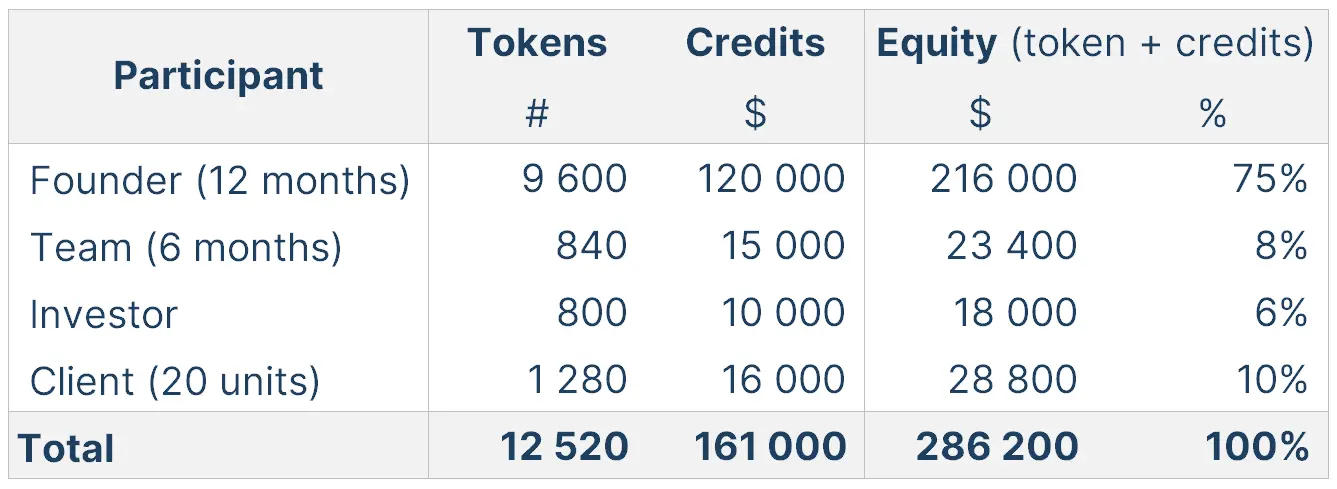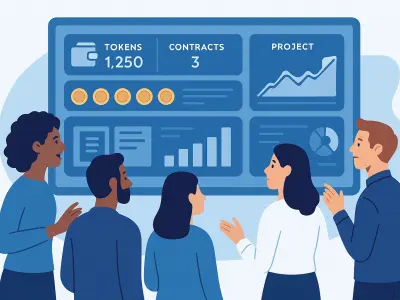The FlexUp Economic Model

Building a new world, together
Aligning financial interests for shared prosperity
FlexUp's innovative economic model promotes wealth creation and fair distribution. It achieves this by aligning the financial interests of all project stakeholders through a unified remuneration system, fostering stronger, more sustainable collaboration and enhancing overall project success.
Aligning financial interests of all stakeholders ...
Many projects and companies struggle not from a lack of talent, but from internal conflict and misaligned incentives. FlexUp addresses this by fostering collaboration, rather than conflict, through a unique economic model.
Building on the core principle of non-discrimination, FlexUp introduces a unified, flexible remuneration system.
This system allows each participant – including founders, employees, clients, suppliers, and investors – to choose how much risk they want to take on the project's success.
Through this model, if the project succeeds, they share the profits in proportion to their contribution and the level of risk they chose to undertake. Conversely, if the project faces challenges, they are all impacted proportionally.
... through a common remuneration system
Each participant can choose how to split their remuneration across three priority levels*:
- Firm: paid first, on a monthly basis (low risk).
- Flex: paid next, on a monthly basis, if sufficient cash remains after paying the Firm (medium risk)**.
- Credit: paid last, on an annual basis, if there is surplus cash left after paying the Firm and Flex (high risk).
The more risk you take, the more Tokens you earn. "Tokens" define your share in the project's profits and voting rights.
FlexUp "Equity" comprises both "Credits" and "Tokens" , dynamically reflecting your investment and contributions on a real-time basis.
Notes:
* This is a simplified overview. For full details, download the FlexUp Economic Model presentation from our downloads page.
** If there is not enough cash to pay the Flex in full to all participants, they are all paid the same percentage, and the unpaid residue is either rescheduled or converted into Credits.

"We're all in the same boat now, so let's work together."
Team & Suppliers
You offer to pay a team member with this flexible remuneration package:
- 2,500 $/month Firm,
- 1,000 $/month Flex,
- 1,500 $/month Credits.
The risk on their remuneration is:
1,000 $ × 20% (Flex risk factor) + 1,500 $ × 80% (Credit risk factor) = 1,400 $ Based on a 10 $/token index, they earn:
1,400 $ ÷ 10 $/token = 140 tokens
Investors
An angel investor wants to invest 10,000 $ in your project. You offer them to invest using FlexUp Credits.
The risk on their investment, based on the Credit risk factor (80%), is:
10,000 $ × 80% = 8,000 $For their 10,000 $ investment, they receive:
- 10,000 $ of credits, plus
- 8,000 $ ÷ 10 $/token = 800 tokens
Client
A client wants to purchase your new device. Given initial production costs are higher than market prices, you offer the following deal:
- 1,000 $ Firm (paid upfront by client)
- minus 800 $ Credits (as a rebate)
The risk the client takes on this future 800 $ Credit rebate is:
800 $ × 80% = 640 $Based on a 10 $/token index, they earn:
640 $ ÷ 10 $/token = 64 tokensExamples
Here are simple illustrations of how the FlexUp flexible remuneration system works in practice, based on the following assumptions:
- Risk factors: Firm 0%, Flex 20%, Credit 80%
- Token index: 10 $/token
To illustrate how the FlexUp Economic Model allows diverse contributions to build shared equity, let's consider the following scenario using the 3 examples given above.
A founder starts working on a new startup project, awarding herself a 10,000 $/month remuneration, 100% as Credits. After 6 months, she hires the team member (the Flex is converted to Credits as there isn't enough cash yet). She raises the funds from the angel investor. At the end of the year, she sells 20 devices to the client. Using the values and payment structure mentionned above, the projet's equity structure at the end of the year would be as follows:

Download the detailed calculation here: xls or pdf
As you can see, in the FlexUp system, there is no difference between founder, team members, investors, clients or suppliers. All get the same credits and tokens, using the same simple rules to calculate their risk, based on the value of their contribution and the payment structure the agreed to.
Objectives
The FlexUp Economic Model is designed to achieve several key objectives for your project, all of its stakeholders and general society as a whole:
Principles
The specific mechanisms that have been designed in the FlexUp Economic Model to achieve the stated objectives are based on the following principles:
Explore the FlexUp App Today
Ready to get hands-on? Here are three ways to experience our platform before the official 2026 launch.
Apply for the Trailblazer Program
Ready to run your real business on FlexUp? Apply for exclusive early access and join a select group of founders shaping our future. This is the full, live version of the app.
✅ Traiblazers get 1-year access to our Pro plan + 2 hours of free hand-on advisory support from our experts.
Explore a Live Demo
See how FlexUp works with concrete examples. Log into our read-only demo environment to explore detailed case studies and understand the platform's value in practice.
📖 You can also read full stories on our blog.
Test Drive in the Sandbox
Just curious? The sandbox is your no-strings-attached playground. Create an account, test features, and experiment with ideas using dummy data. It's safe, easy, and temporary.
🧪 Sandbox data is temporary and regularly cleared. Use it for testing and exploration only.
Want to dive deeper?
Here are a few ressources to learn more about the FlexUp Economic Model.
The FlexUp Charter is a 70-page contract that defines in great detail the way a projet is run using the FlexUp Economic Model.
You can get it in our the Contract Templates page (💡signup required to access this page).









